Protect your data
This site uses cookies and related technologies for site operation, and analytics as described in our Privacy Policy . You may choose to consent to our use of these technologies, reject non-essential technologies, or further manage your preferences.
- Resume and Cover Letter
- How to Address a Cover Letter...

How to Address a Cover Letter to Recruiter or Hiring Manager
5 min read · Updated on November 24, 2021

Knowing how to effectively address a cover letter makes you a very visible and appealing candidate.
Did you know that the cardinal rule of cover letters is personalization? It impresses a hiring manager or recruiter because it tells them you took time to research the specific information for the letter rather than sending a generic version.
What many people forget, however, is that the greeting or salutation in a cover letter must also be personalized with the hiring professional's first and last name whenever possible.
There are several effective ways to find the hiring manager's name for your greeting — and some acceptable back-up strategies when you can't. Either way, knowing how to address a cover letter effectively can prevent you from ending your hiring chances before they even begin.
When you know the hiring manager's name
More often than not, you'll be given the name of the hiring professional or the manager that you'll work for. Whoever it is, use their full name (first and last name) in the greeting.
If you cannot definitively tell the gender of the hiring person, do not use a gender-based title such as “Mr.” or “Ms.” in the greeting. Instead just use the person's full name.
For example, Alex Johnson could be male or female. To avoid a gender mistake, use Dear Alex Johnson, Hello Alex Johnson, or simply Alex Johnson .
However, professional titles such as “Professor” or “Dr.” are definitely acceptable as a cover letter salutation and should be used as a sign of respect. Be on the lookout for these and other titles to include.
How to find a hiring manager's name for your cover letter
If you're not given the name of the hiring manager, here are some effective ways to discover their name by using:
The job description: Check this document for the hiring manager's name. While it's not generally listed, you never know. If it's not obvious, there's also a trick to quickly discover an email in the job description that might contain the name; while in the document, press Ctrl +F or run Command + F and search for the @ symbol.
An email address: If you discover an email address, it may not have a full name but rather a first initial and last name or just a first name like [email protected] or [email protected] . A Google search combining the person's name as shown in the email and the company name might find you the person's full name.
A LinkedIn post: A name connected to the LinkedIn job posting is probably that of the hiring professional who posted it, so use that name in your greeting.
The supervisor's title: It's more likely that a job description will list who the new hire will report to — such as the director of accounting — without listing a name. In this case, there are several search options:
Search the company's website for listings of staff members by title.
Run an advanced LinkedIn or Google search for all directors of accounting at that specific company.
Check with your network for someone who might know the person's name or search the appropriate professional networking sites.
Contact the company by phone or email. Tell them you're applying for [job title] and want to address your cover letter to the right person.
In the end, this research can be the difference between making a great first impression and getting noticed for the position — or getting totally ignored by the hiring manager.
Acceptable options in lieu of a name
If you try the steps above and come up empty, there are still some alternative greeting options that will put you in a professional light.
The idea is to show that you've read the job description and tailored your greeting based on the company department where the job is located, the hiring manager's title, or the team with which you'll potentially work.
Some good examples include:
Dear Head of Design
Hello IT Department
Dear Accounting Manager
To Company ABC Recruiter/Hiring Professional
Hello Marketing Hiring Team
Dear Customer Support Hiring Group
Dear Human Resources
If you still can't find any specific name or department information, go with “Dear Hiring Manager.” It sounds professional and it's not gender-specific. In fact, a recent survey of over 2000 companies by Saddleback College showed that 40 percent preferred “Dear Hiring Manager” as the best greeting when a manager's name can't be found.
“Dear Sir or Madam” is another option that works because it's gender-neutral and respectful. However, it sounds a bit old-fashioned and may signal a hiring professional that you're an older worker or just not aware of other greeting options. It's perfectly acceptable, but the better choice is “Dear Hiring Manager.”
In the end, an actual name or any of the alternative examples will let you stand out from the crowd, so do your best to find and use those whenever you can.
Never leave the greeting blank
Whatever information you may or may not find, it's important to never leave your greeting line blank.
A blank greeting line can make you come across as lazy or rude, or imply that you simply don't understand how to write a cover letter — all of which will immediately put you out of contention for the job. There's no reason to leave the greeting blank when there are so many options that can be used effectively.
When you spend the time and effort to personalize your cover letter, you don't want to come across as “just another candidate” by using a generic greeting or no greeting at all.
A personalized greeting will impress any hiring professional, increasing the chance they'll read your entire cover letter — and ask you for an interview.
Not sure if your cover letter is cutting it? Our writers don't just help you with your resume .
Recommended Reading:
Do Hiring Managers Actually Read Cover Letters?
5 Things to Say in Your Cover Letter If You Want to Get the Job
How To Write a Cover Letter (With Example)
Related Articles:
How to Create a Resume With No Education
From Bland to Beautiful: How We Made This Professional's Resume Shine
See how your resume stacks up.
Career Advice Newsletter
Our experts gather the best career & resume tips weekly. Delivered weekly, always free.
Thanks! Career advice is on its way.
Share this article:
Let's stay in touch.
Subscribe today to get job tips and career advice that will come in handy.
Your information is secure. Please read our privacy policy for more information.

6 Examples: How To Address a Cover Letter Without a Name
By Status.net Editorial Team on December 25, 2023 — 11 minutes to read
Addressing the recipient without knowing their name might seem complicated, but there are ways to navigate this situation. Let’s take a look at a few strategies to make your cover letter feel personalized even when you don’t have a specific name to address.
Be Professional and Engaging
Using general salutations like “To Whom It May Concern” or “Dear Sir/Madam” can make your cover letter feel impersonal. Instead, opt for a more engaging opener such as “Dear Hiring Manager” or “Dear [Company Name] Team.” This type of greeting acknowledges the company and shows that you have researched the team you are addressing.
Focus on the Position and Company
Make sure to tailor the content of your cover letter to the job you are applying for by highlighting relevant qualifications, experience, and skills. Share specific examples of your successes that align with the responsibilities of the position. Mention the company’s values, goals, or recent successes to demonstrate how your values align with theirs. This can effectively showcase your interest and commitment to the role.
Use LinkedIn and Company Website Research
If you cannot find the hiring manager’s name in the job posting, you can turn to LinkedIn or the company website for clues. Search for professionals working in human resources or hiring roles at the company. If you find a specific contact, address your letter to that person while using their full name and title. Otherwise, continue with a professional and engaging salutation as mentioned earlier.
Here are two examples of how to start a cover letter without a name:
Dear Hiring Manager, As a passionate marketer with five years of experience, I am excited to apply for the Marketing Manager position at (…) Company. Achieving a 30% increase in leads generated through my previous campaigns, I am eager to contribute to the growth of your marketing department.
Dear ABC Inc. Team, With a strong background in project management and a proven track record of implementing cost-saving strategies, I am confident in my ability to excel as the Senior Project Manager at ABC Inc. Your company’s commitment to sustainable practices aligns with my values and I am thrilled to be considered for this opportunity.
By applying these strategies, you can create an impactful and personalized cover letter, even without knowing the recipient’s name. This attention to detail can set you apart from other applicants and leave a positive impression with your prospective employer.
How to Find the Hiring Manager’s Name
Sometimes locating the hiring manager’s name can be tricky, but there are several ways to find it. Let’s go through a few methods to help you address your cover letter without a name.
Using LinkedIn
LinkedIn is a great resource for finding the hiring manager’s name. Here’s how you can use it:
- Visit the company’s LinkedIn page.
- Click on the “People” tab to browse through the employees.
- Use the search bar and enter keywords such as “recruiter,” “hiring manager,” or the department you’re applying to.
- Check the found profiles, and try to identify the right person responsible for hiring in your desired role.
Make sure to double-check that the person is currently working in the company to avoid using outdated information.
Checking Company Website
Another way to find the hiring manager’s name is by checking the company website:
- Locate the “About Us” or “Team” page, where you might find a list of employees along with their titles and roles.
- Look for a person who has a recruiting or hiring-related title within the department you’re targeting with your application.
- If you cannot find the necessary information on the website, try checking a company’s press releases or blog. Sometimes they include names of important team members.
Making a Phone Call
When all else fails, you’re left with one more option – making a phone call.
- Call the company’s main line and politely ask the receptionist for the name of the hiring manager or the person responsible for recruitment in the department you’re interested in.
- Be prepared to provide the job title and a job reference number (if available) to help the receptionist find the right person.
Finding the hiring manager’s name isn’t always possible. If you cannot locate it, don’t worry. Addressing your cover letter as “Dear Hiring Manager” or “To Whom It May Concern” is still better than not sending a cover letter at all.
How To Address a Cover Letter Without a Name: Sample Phrases
Starting with job title.
When you cannot find the recipient’s name, use their job title to address the cover letter. This shows that you can connect and direct your message to the relevant person. Here are some examples:
- Dear Hiring Manager, – This is a common and universally understood phrase for addressing a cover letter without a name.
- Dear [Job Title], – Use the specific job position that the recipient holds, for instance, Dear Marketing Director .
- To the [Job Title] Selection Committee, – This approach can be useful when applying for a role advertised by a team or committee that will handle the hiring process, such as To the Scholarship Selection Committee .
Referring to Department
Another approach is to address the cover letter to the department that the position is within. This helps to direct your message to the appropriate team or group. Here are some examples:
- Dear [Department] Team, – Mention the department you are applying for, such as Dear HR Team, or Dear Sales Team .
- Greetings, [Department] Department, – Use the department name to address the letter, like Greetings, IT Department .
- To Whom It May Concern in the [Department], – This is a formal alternative when you don’t know the recipient or department’s name, for example, To Whom It May Concern in the Finance Department .
Using these approaches will ensure that your cover letter appears professional and well-directed, even when you don’t have the exact name of the recipient. Focus on the content and the skills you bring to the position to make the best impression on the reader.
Crafting Content for Cover Letters
When you’re unsure of the recipient’s name, you might feel a little lost on how to address your cover letter. Don’t worry. You can still create an engaging and professional cover letter that gets the job done. Here are some tips and examples to help you craft the perfect content for an anonymous cover letter.
Start with a professional, yet friendly, greeting. If you don’t know the hiring manager’s name, use a general opening line such as “Dear Hiring Manager” or “To Whom It May Concern” . These greetings are widely accepted and show respect towards the person receiving the letter.
Next, dive into your strengths, skills, and achievements. Mention the qualifications that make you a strong candidate for the position. Share relevant accomplishments from your previous roles, such as leading a successful project or boosting sales. Be specific when describing your skills and use quantifiable results when possible. For example:
“During my time at Company (…), I managed a team of 10 and successfully increased sales by 25% within six months.”
Show enthusiasm for the job and demonstrate your knowledge of the company. Research the organization’s goals, values, and recent projects, then incorporate this information into your cover letter. This will help you tailor your letter to the company’s needs and show that you’d be a good fit for their culture. You could say something like:
“As a long-time admirer of your company’s commitment to sustainability, I’m excited about the opportunity to contribute to the upcoming eco-conscious product line.”
Close your cover letter with a strong call-to-action. Express your interest in further discussing your qualifications and offer your availability for an interview. Thank the hiring manager for considering your application and include your contact information. A sample closing paragraph could look like this:
“I’m eager to discuss how my expertise in digital marketing could contribute to the success of your team. Thank you for considering my application. You can reach me at (555) 555-5555 or [email protected] to schedule a conversation.”
Keep your cover letter concise and focused on your unique selling points. Even without knowing the recipient’s name, following these guidelines will allow you to create a memorable and attention-grabbing cover letter that leaves a lasting impression on potential employers.
Tips on Prefix Usage
When you’re addressing a cover letter without a specific name, it’s good to think about the appropriate prefix to use. Here are some tips to help you choose the right one:
First, consider using a general and gender-neutral prefix like Dear Hiring Manager . It will work well if you don’t know the recipient’s name or aren’t aware of their gender. This is a widely accepted way to address a cover letter without a specific name.
Dear Hiring Manager, I came across your job posting for a Graphic Designer, and I am excited to apply for the role.
If you happen to know the job title of the person who will read your cover letter, you can use it. This shows that you have put effort into researching the company and position.
Dear Marketing Director, I am writing to express my interest in the open Digital Marketing Specialist position at your company.
In some cases, you might know the name of the department that the job is in. In this case, you can address your cover letter to the entire department.
Dear Finance Team, I was thrilled to see an opening for a Financial Analyst at your company and would like to apply for the position.
When you’re unable to find any specific details or when addressing a larger company, you can opt for a broad salutation like To Whom It May Concern . Just be aware that it may come off as impersonal, so it’s best to use this as a last resort.
To Whom It May Concern, I am submitting my application for the Content Writer position posted on your careers website.
The key is to maintain a professional tone throughout your cover letter. Regardless of which prefix you choose, always customize your content to suit the specific job and company you’re applying to. By doing so, you demonstrate a genuine interest in the role and leave a positive impression on the hiring manager.
Common Mistakes to Avoid
Sending a cover letter without addressing it to a specific person can be a pitfall. It might make the recipient feel unimportant or signal that you didn’t do your research. To make your application stand out, be mindful of these common mistakes:
- Not being specific about the role: Your cover letter should not only address the person but also the specific role you’re applying for. Tailor your letter according to the job and the company. For instance, instead of writing “I wish to apply for the marketing position”, be more specific like “I am interested in applying for the Digital Marketing Specialist role at [CompanyName].”
- Focusing too much on yourself: Although your achievements are important, the cover letter should focus on how your skills can benefit the company. Frame your accomplishments in a way that highlights the value you can bring to the organization.
- Being overly formal or stiff: While it’s important to maintain a professional tone, being too formal might come across as insincere or impersonal. Use a friendly tone and avoid jargon or buzzwords to keep your cover letter genuine and relatable.
- Spelling errors and typos: Even the smallest of typos can create a negative impression. Double-check your cover letter to make sure there are no mistakes. Keep an eye out for incorrect spellings, especially when addressing the recipient.
The goal of your cover letter is to make a personal connection and showcase how you are a great fit for the company. Taking the time to address your letter properly, proofread for errors, and customize your content demonstrates your attention to detail and commitment to the position.
Frequently Asked Questions
How can i properly address a cover letter when the recipient’s name is unknown.
If you don’t know the recipient’s name, consider using a general salutation instead. For example, “Dear Hiring Manager” or “Dear Recruitment Team” acknowledges the recipient without using a specific name. You can also research the company’s website or LinkedIn to try to find the appropriate contact person.
What alternatives are there to ‘To Whom It May Concern’?
There are several alternatives to ‘To Whom It May Concern’ that can help make your cover letter stand out:
- Dear Hiring Manager
- Dear [Company] Team
- Dear [Department or Job Title] Hiring Team
- Dear [Company] Recruitment Team
How do I determine the appropriate salutation for my cover letter?
To determine the right salutation for your cover letter, do a bit of research on the company or organization you’re targeting. This may help you uncover the specific department or hiring manager’s name. If not, use one of the general salutations mentioned earlier to address your cover letter in a more personalized manner.
What are examples of cover letter openings without using names?
Here are some examples of cover letter openings without using specific names:
- “Dear Hiring Manager, I am excited to submit my application for the [Job Title] position at [Company].”
- “Dear [Department or Job Title] Hiring Team, As a passionate professional with experience in [Industry], I am eager to contribute to [Company] as a [Job Title].”
- “Dear [Company] Team, I recently came across the [Job Title] opening at [Company], and I am confident that my skills and experience make me a strong candidate.”
How can I avoid common mistakes when addressing cover letters without names?
To avoid mistakes when addressing cover letters without names, follow these tips:
- Do thorough research on the company and the job posting
- Be concise and professional in your language
- Use an appropriate general salutation if you can’t find a specific name
- Double-check for spelling and grammatical errors before sending the cover letter
- Avoid using outdated or overused phrases, such as ‘To Whom It May Concern’ or ‘Dear Sir/Madam’
By following these guidelines, you can create a strong and effective cover letter that stands out to hiring managers, even if you don’t have a specific name to address.
- 5 Compelling Examples of Cover Letter for Warehouse Job
- 3 Inspiring Nonprofit Cover Letter Examples
- How to Send an Email Cover Letter (Examples)
- Resume vs. Cover Letter (Thoughtful Tips)
- 3 Examples: What's the Ideal Cover Letter Length?
- 5 Key Parts of an Effective Cover Letter (with Examples)
Resume Templates
Resume samples
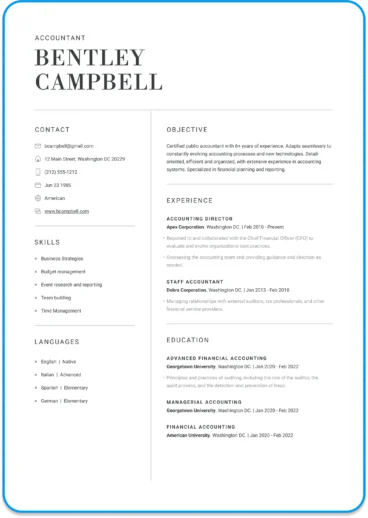
Create and edit your resume online
Generate compelling resumes with our AI resume builder and secure employment quickly.
Write a cover letter

Take a look at our cover letter guides and examples, to help you write a cover letter that complement your resume and enhace your applications.
Cover Letter Examples
Cover Letter Samples
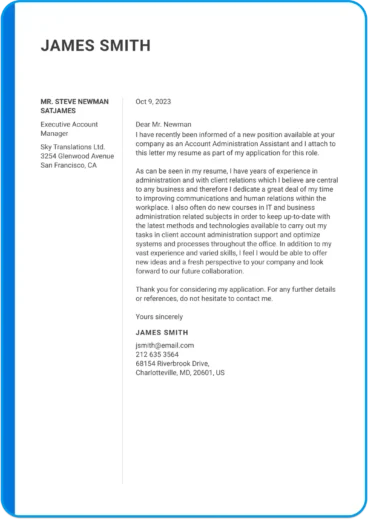
Create and edit your cover letter
Use our user-friendly tool to create the perfect cover letter.
Featured articles
- How to Write a Motivation Letter With Examples
- How to Write a Resume in 2024 That Gets Results
- Teamwork Skills on Your Resume: List and Examples
- What Are the Best Colors for Your Resume?
Latests articles
- Best Online Jobs for Teens in 2025
- 10 Jobs for Extroverts To Succeed in
- How To Create a Winning Plain Text Resume: A Comprehensive Guide
- Should You Put Your GPA on Your Resume?

Dive Into Expert Guides to Enhance your Resume
How to Address a Cover Letter

In a competitive job market it is crucial to make the best first impression you can. Small things like the cover letter salutation can make a big difference. Nailing the cover letter opening conveys professionalism and adds that personal touch .
It is always best to try and find out the name of the hirer on the company website, by calling the company receptionist, or by looking on LinkedIn. If the name is readily available and you don’t use it, the hirer will think that you’ve rushed and haven’t taken the time to get the cover letter greeting right.
However, it is not always possible to find out the contact person’s name. In these cases, it can be difficult to know how to address an email cover letter and if you get it wrong, the danger is that your carefully constructed professional resume may never be viewed. The good news is that there are options for how to open a cover letter and it is not complicated.
How to start a cover letter
Ideally, you should have the right person’s name . It is generally best to use ‘Dear’ followed by either ‘Mr’ or ‘Ms’ (unless you specifically know that a woman prefers ‘Miss’ or ‘Mrs’).
If you’re not sure of a person’s gender because they have a name which could be both, use their full name and leave off the salutation. If you know that someone is a qualified professor or doctor you should use the appropriate letter salutations .
Cover letter salutation examples:
- Dear Ms. Jenkins
- Dear Mr. Washington
- Dear Dr. Brown
- Dear Professor Simon
- Taylor White
How to address a cover letter without a contact name
Many job postings don’t include a contact name and even with a bit of investigating you can’t find out who the hiring manager is. Sometimes companies prefer the hiring manager to be anonymous for various reasons.
In these cases, you can use general salutations for addressing your cover letter . Many choose the classic cover-letter ‘To whom it may concern’ . This is absolutely fine though a little old-fashioned, consider the company image and think whether it’s suitable or not. Here are some other general salutations you can use :
- Dear Hiring Manager
- Dear Company Name
- Dear Sir or Madam
- Dear HR Manager

Tips for writing a polished cover letter
Main body of the cover letter.
How long should a cover letter be? Your cover letter should be concise . It should let the employer know what position you’re applying for and what your main strengths are. It should not be as detailed as your resume but should focus on a few key points . Read this guide on what not to put in a cover letter .
Identify the most important requirements in the job posting and focus on these. Make sure you follow the employer’s instructions to the letter and proofread your cover letter numerous times before sending it.
Cover letter ending
In the final paragraph of the cover letter , let the employer know that you’ve attached your resume (assuming you have). Thank them for their time and for considering you for the position. You can finish with the closing line ‘Yours Sincerely’ , followed by your email signature.
Email signature
If you’ve taken time to write a resume which grabs the attention of the employer and have written a polished cover letter , you’ll hopefully get through to the interview stage . It would be a tragedy if the employer didn’t know how to contact you, so make this clear in your email signature. Make sure you include the following:
- Address (including city, state, and zip code)
- Cell number
You can also include any social media links , such as LinkedIn, if it helps your application.
Email subject line
This is one of the most common mistakes that candidate’s make and it looks sloppy. The hiring manager receives so many emails that they might not open an untitled email. Write a clear email subject line which includes the position you’re applying for.
Lastly, remember to attach your resume ! If you forget, the hirer may send a polite email telling you to resend it, or they may not bother. Many candidates use a resume builder to create attractive, professional-looking resumes which stand out.
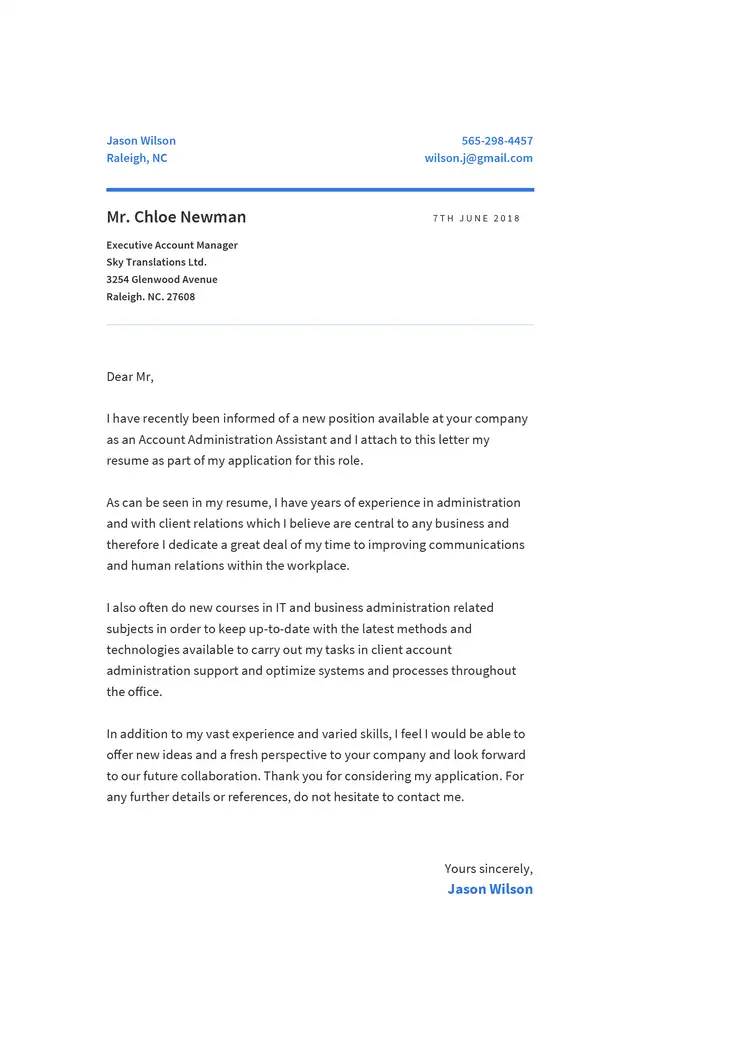
Write your cover letter
Introduce yourself to the recruiters using one of our professional templates.
Related Blog

12 CV cover letter examples
A cover letter for your CV, or covering note is an introductory message that accompanies your CV when applying for a job.
The purpose of the cover letter is simple… Persuade the reader to open your CV.
Learn how to write a cover letter properly, and you will hugely increase your chances of getting responses and landing job interviews.
This guide, with 12 annotated cover letter examples will show you everything you need to know about creating a winning cover note.
CV templates
How to layout a cover letter for your CV
This annotated example of a cover letter shows you how you should structure your cover letters, and the type of information you should be including.
You should always write your CV in the body of your email (or j ob site messaging system) so that it can be read instantly. Never attach it as a separate document, or the recipient probably won’t open it.
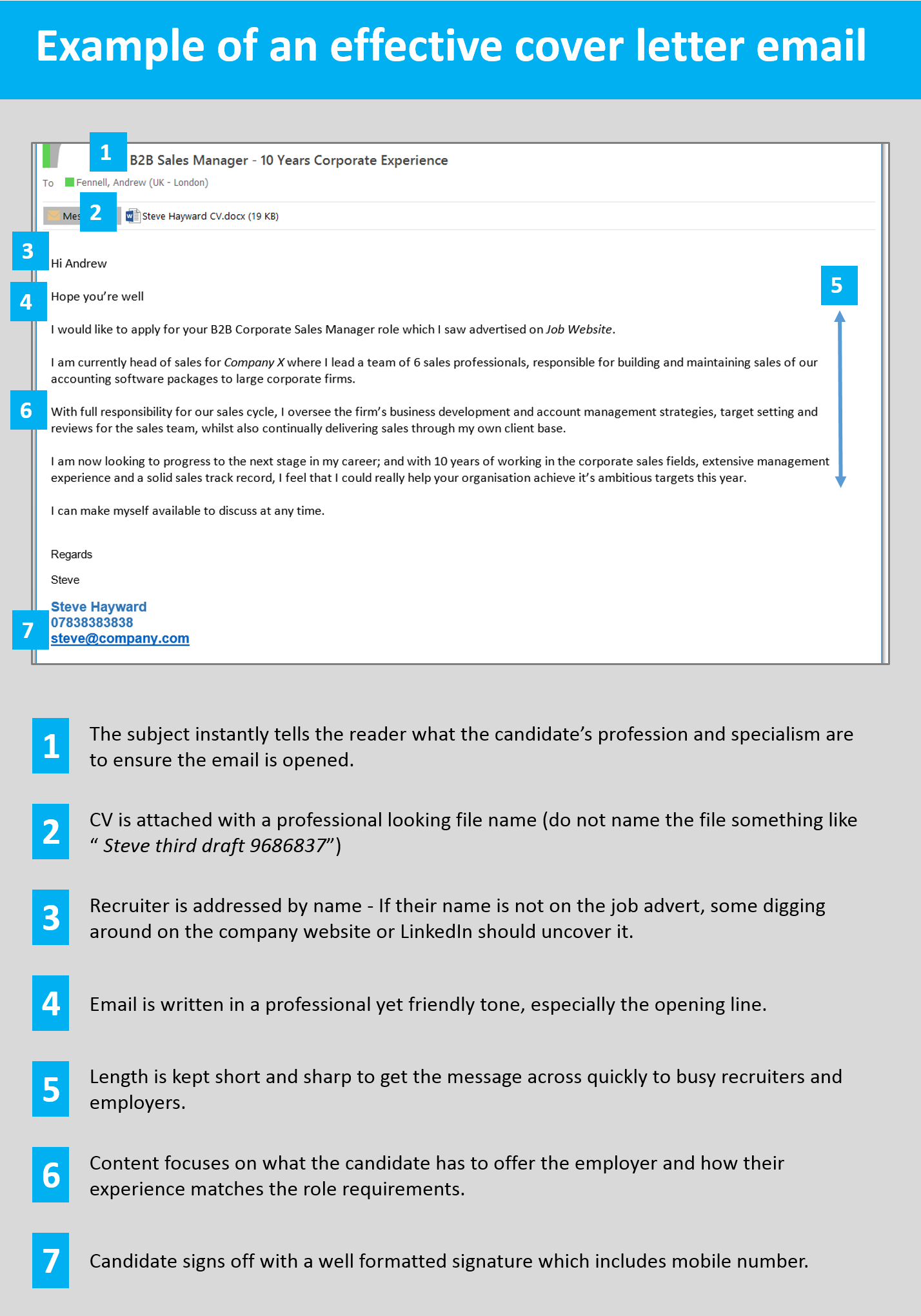
Example CV cover letters
These 11 example CV cover letters from a range of industries should give you some good inspiration for creating your own cover letter.
Admin CV cover letter
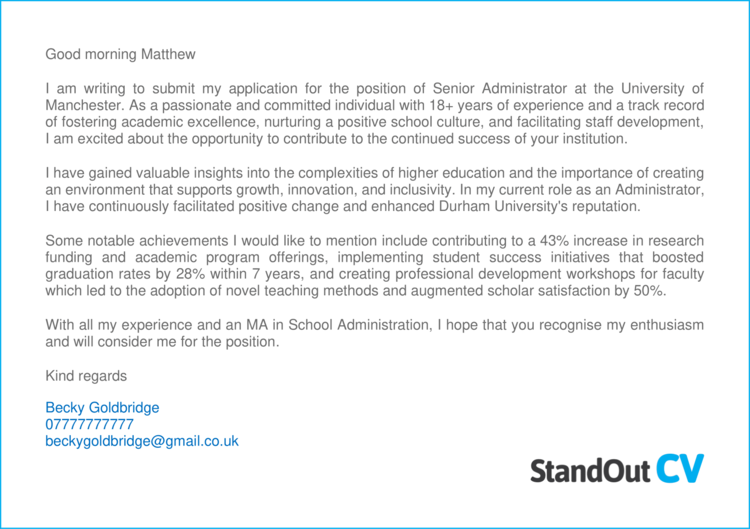
This cover letter is aimed at administrative roles , so it highlights the candidate’s abilities in efficiency, report writing and meeting deadlines, whilst demonstrating the types of environments they have worked in.
Learn how to write a cover letter step-by-step here.
Customer service CV cover letter
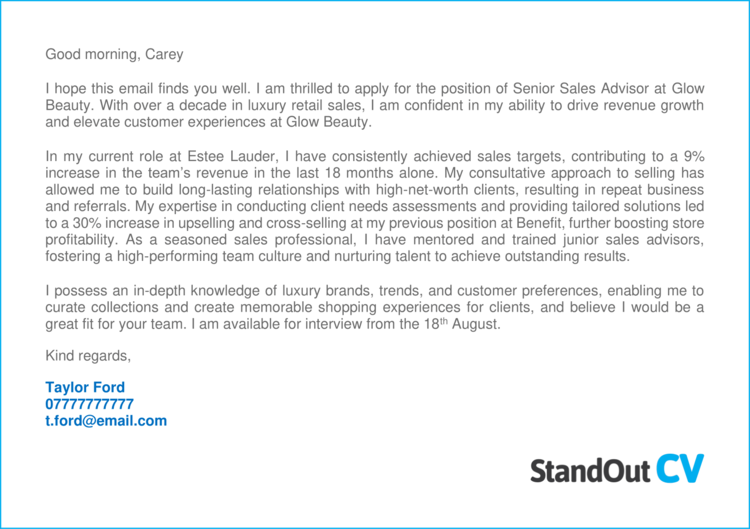
This customer service cover letter briefly explains the candidate’s length of experience in the field and highlights some of the more important customer service skills such as call handling, order taking and complaint resolution.
This gives the reader an excellent introduction to the candidate and should certainly encourage them to open the CV.
See our full customer service cover letter guide, sales assistant cover letter example and waiter/waitress cover letter example .
Finance CV cover letter
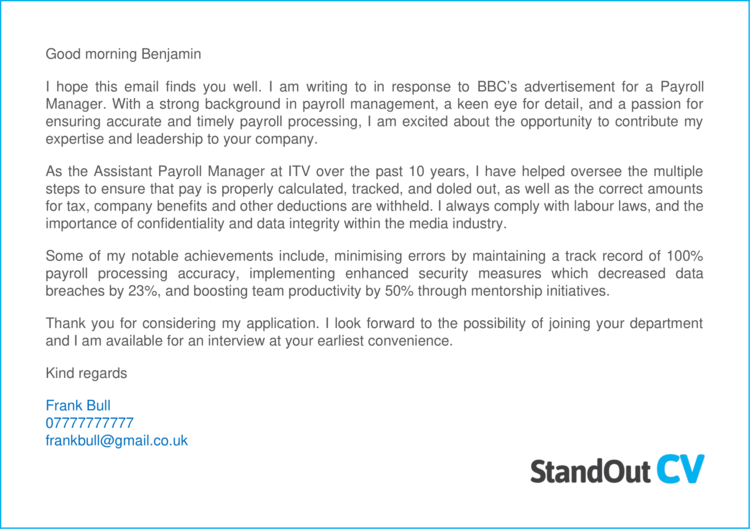
As a finance professional, it’s important to highlight your specialisms within finance, the types of companies you’ve worked for, and high level functions you’ve carried out within your cover letter. This will give the hiring manager a good overall feel of your abilities, and if it’s well tailored to the role, should provide them with enough info to excite them about your CV.
Quick tip: Use our job application tracker spreadsheet to track your applications and follow up with employers who don’t respond.
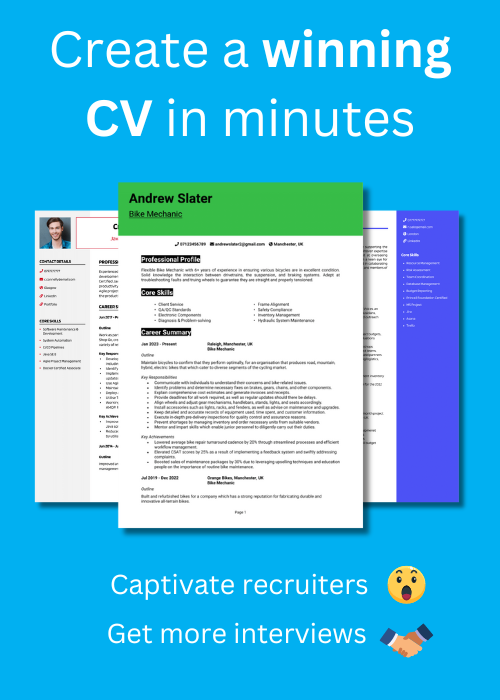
Build your CV now
Events CV cover letter
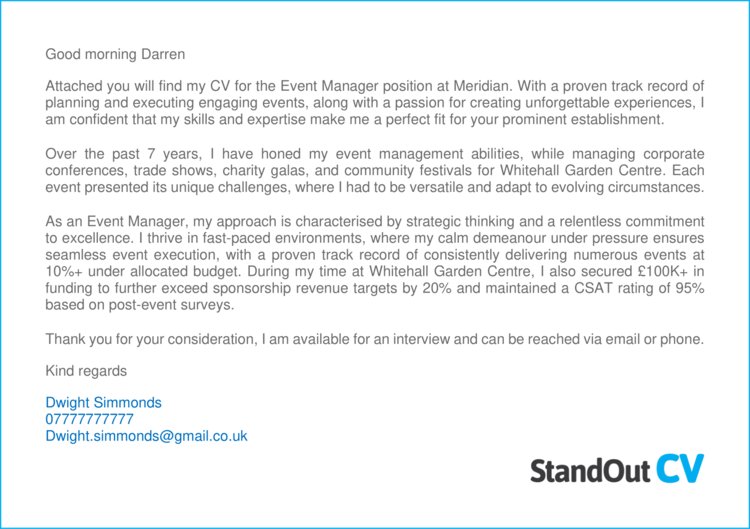
This events manager candidate has done a great job of summarising the type and size of events they manage, along with details of core skills such as leadership, project delivery and stakeholder management.
This certainly provides enough info to create a buzz around the CV attached and encourage the recipient to open it.
Executive assistant CV cover letter
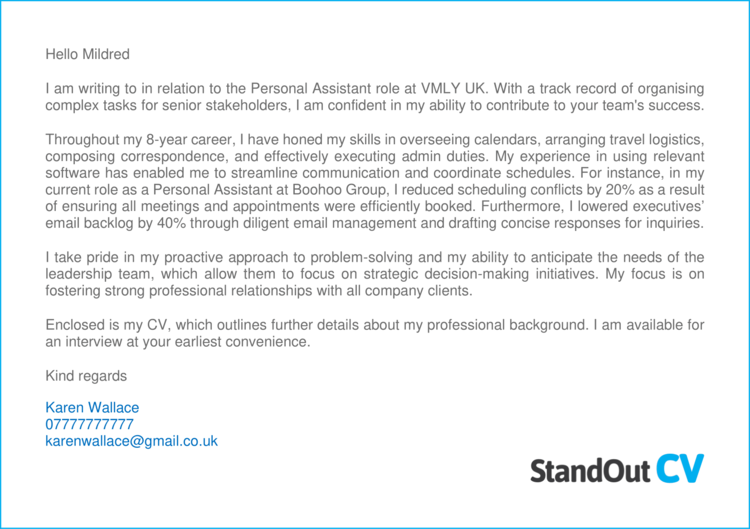
This executive assistant CV cover letter provides a good high level intro to the candidate showing the reader key business support knowledge in areas such as admin, diary management and document management. It also shows that the candidate is confident supporting senior business figures.
Graduate CV cover letter
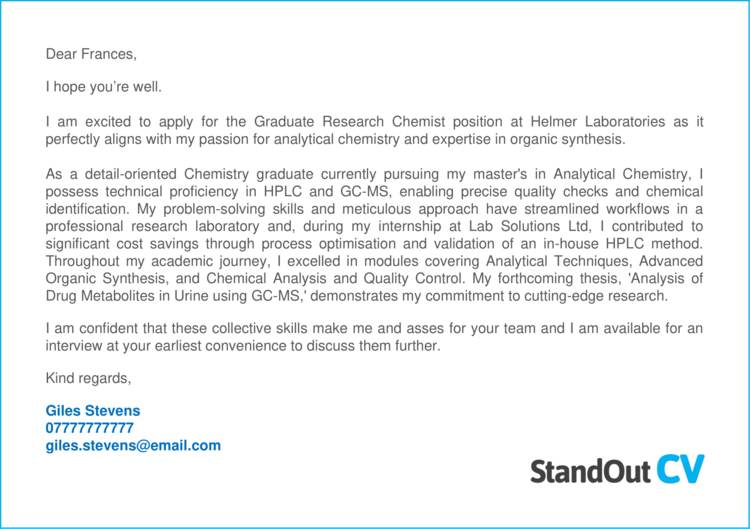
As a graduate , your cover letter will need to be a little longer than an experienced candidates, to compensate for your lack of experience and really sell yourself.
This candidate speaks in lots of detail about their education, qualifications, and extra-curricular work which relates to the roles they are applying for.
IT CV cover letter
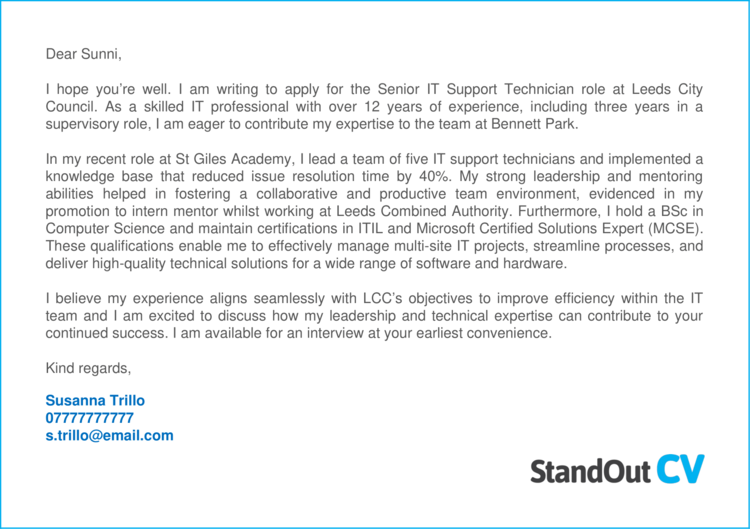
As an IT candidate, it’s important not only to highlight your technical skills, but also show how you apply those skills in the workplace to translate real benefits for your employer.
This candidate gives a good overview of the candidates technical abilities and the types of projects they apply them to, along with results they achieve.
Marketing CV cover letter
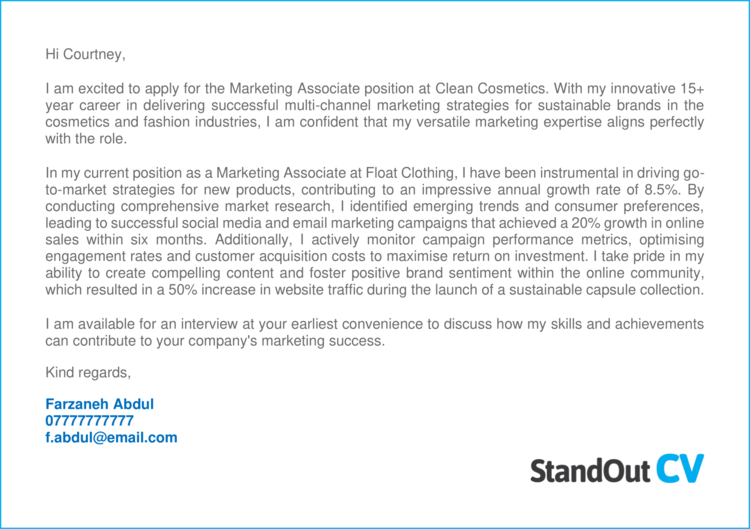
This marketing cover letter provides readers with a summary of the candidate’s core marketing abilities such as media planning, brand awareness and cost reduction. It also explains the types of marketing campaigns and companies they have experience with – a great high-level intro.
Cover letter examples
Warehouse Operative cover letter – Training Contract cover letter – Cleaning Job cover letter – Nursery Assistant cover letter – Recruitment Consultant cover letter – Dental Nurse cover letter –
Chef cover letter – Editorial Assistant cover letter – Aircraft Mechanic cover letter – Biomedical Science cover letter – Cabin Crew cover letter – Finance Assistant cover letter – Hotel Receptionist cover letter – Asset Management cover letter – Assistant Psychologist cover letter – Beauty Therapist cover letter – Cafe Worker cover letter – HR Administrator cover letter – NQT cover letter – Quantity Surveyor cover letter
More cover letter examples
- Academic cover letter
- Account Manager cover letter
- Accountant cover letter
- Accounting cover letter
- Accounts Assistant cover letter
- Acting cover letter
- Admin Assistant cover letter
- Administrator cover letter
- Apprenticeship cover letter
- Architecture cover letter
- Assistant Manager cover letter
- Banking cover letter
- Bar Staff cover letter
- Barclays cover letter
- Barista cover letter
- Bartender cover letter
- Business Analyst cover letter
- Business Development Manager cover letter
- Car Sales Person cover letter
- Care Assistant cover letter
- Career Change cover letter
- Catering Assistant cover letter
- Civil Engineer cover letter
- Computer Science cover letter
- Consulting cover letter
- Copywriter cover letter
- Cyber Security cover letter
- Data Entry Clerk cover letter
- Data Scientist cover letter
- Delivery Driver cover letter
- Digital Marketing cover letter
- Electrician cover letter
- Engineering cover letter
- Estate Agent cover letter
- Event Manager cover letter
- Exam Invigilator cover letter
- Executive Assistant cover letter
- Fashion Designer cover letter
- Finance cover letter
- Financial Analyst cover letter
- Google cover letter
- Graduate cover letter
- Graduate Engineer cover letter
- Graduate Scheme cover letter
- Graphic Design cover letter
- Health Care Assistant cover letter
- Hospitality cover letter
- HR Assistant cover letter
- HR cover letter
- Interior Designer cover letter
- Internal Position cover letter
- Internship cover letter
- Investment Banking cover letter
- Investment Manager cover letter
- IT Support cover letter
- Journalist cover letter
- JP Morgan cover letter
- Lawyer cover letter
- Legal Assistant cover letter
- Legal cover letter
- Library Assistant cover letter
- Manager cover letter
- Marine Engineer cover letter
- Marketing Assistant cover letter
- Marketing cover letter
- Marketing Intern cover letter
- Marketing Manager cover letter
- McKinsey cover letter
- Mechanical Engineer cover letter
- Medical Receptionist cover letter
- Medical Writer cover letter
- Model cover letter
- Nanny cover letter
- Nurse cover letter
- Nursing cover letter
- Office Assistant cover letter
- Office Manager cover letter
- Operations Manager cover letter
- Optical Assistant cover letter
- Paralegal cover letter
- Part Time cover letter
- PE Teacher cover letter
- Personal Assistant cover letter
- Personal Trainer cover letter
- Pharmacist cover letter
- Pharmacy Assistant cover letter
- PHD Application cover letter
- Photographer cover letter
- Placement cover letter
- Private Equity cover letter
- Product Manager cover letter
- Production Assistant cover letter
- Production Operator cover letter
- Project Coordinator cover letter
- Promotion cover letter
- PWC cover letter
- Quantity Surveyor cover letter
- Receptionist cover letter
- Research Assistant cover letter
- Researcher cover letter
- Retail Assistant cover letter
- Retail cover letter
- Retail Manager cover letter
- Sales Advisor cover letter
- Sales Executive cover letter
- Sales Manager cover letter
- Scrum Master cover letter
- Security Officer cover letter
- Ski Season cover letter
- Social Media Executive cover letter
- Social Media Manager cover letter
- Software Developer cover letter
- Software Engineer cover letter
- Speculative cover letter
- Student cover letter
- Support Worker cover letter
- Teaching Assistant cover letter
- Team Leader cover letter
- Trainee Dental Nurse cover letter
- University cover letter
- UX Designer cover letter
- Volunteer cover letter
Project manager CV cover letter

A project manager’ s cover letter needs to quickly explain to recipients the types of projects they lead and the technical expertise they bring to the projects. It’s also important to describe level of experience, seniority and background.
See full project manager cover letter example + writing guide
Operations manager cover letter
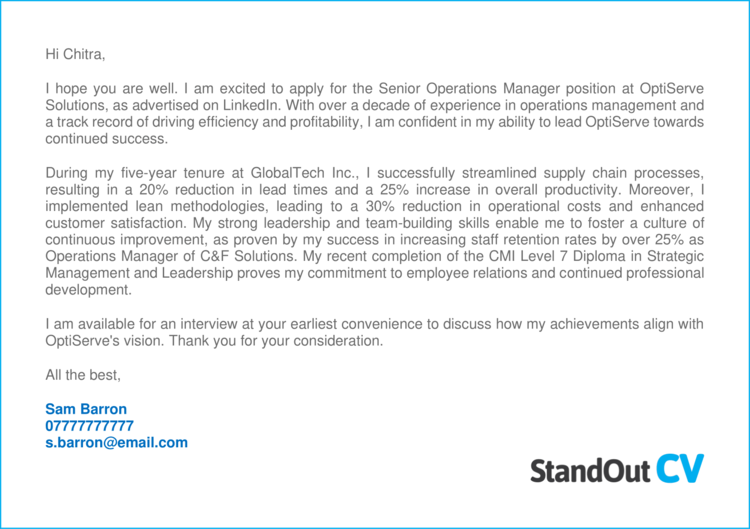
This operations management CV provides a brief introduction to the types of operations the candidate manages and the firms they work for.
They also touch upon some core operations skills such as efficiency, logistics and ROI improvement.
Sales CV cover letter
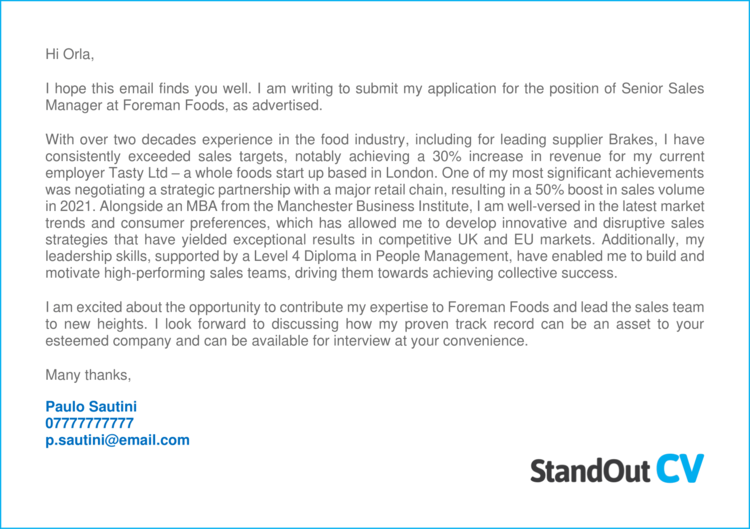
As a sales candidate, this cover letter shows the types of business this person can generate and the size and scale of the impact they create by highlighting some sales results.
It also mentions some core sales skills like business development, presenting, working under pressure and closing deals.
Cover letter templates
Teacher cover letter
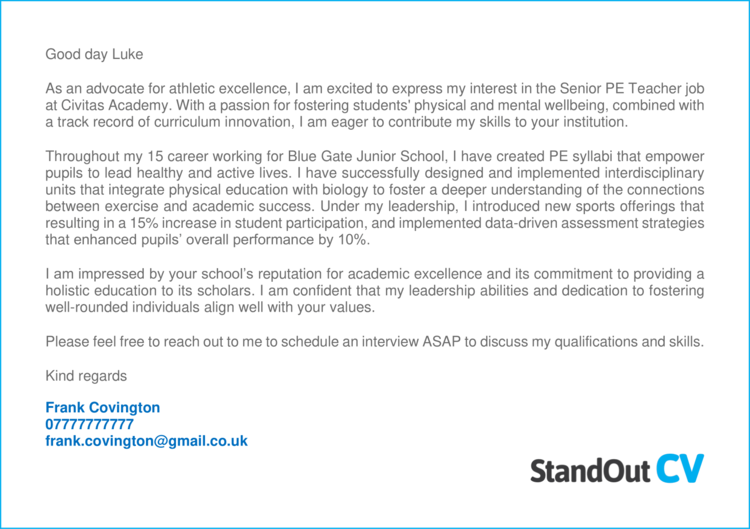
This teacher cover letter does a great job of introducing the candidate, and showing the recipient the key facts they will be looking for, such as; the age group they teach, subject specialisms, and the results they have achieved.
The cover letter is brief and gets to the point quickly, so that readers will instantly look to open the attached CV .
How to write your CV cover letter
Now that you’ve seem good examples of cover letters to accompany your CV (or resume if you are in the USA) this guide will show exactly how to write your own, and the content that needs to be included .
Send your CV cover letter in email format (when possible)
When applying for jobs online you usually have 2 choices…
1) Send a message via the job website’s messaging system
2) Send the recruiter an email directly
If you can find an email address for the recruiter, then I would always recommend sending an email directly because it gives you more control.
When you send a message through a job website, it will transfer into an email with basic formatting and an auto-generated headline , which will look like this when the recruiter receives it.

If you cannot find an email address for the recruiter on the job advert, then try searching LinkedIn or the company website to find the relevant contact.
You may not always be able to find an email address, but when you can – always send a job application by email .
Make your subject line appealing
As you can see in the picture above, a bad subject line can kill your chances of actually having your email read in the first place.
Your subject line should stand out and give the recruiter a reason to open your email.
When recruiters look into their inbox, they are looking for one thing; a candidate who can do the job they are advertising – so give that to them in your subject line.
Your subject line should be a short summary of your experience that relates directly to the job you are applying for.
The following are good subject line examples;
KS2 Teacher with 5 years experience
Front End Web developer with HTML, HTML & JavaScript experience
Junior Graphic designer with 1st BA Hons Graphic Design
If your subject line shows that you have one or two of the most important requirements for the job, your email should get opened every time.
Address the recruiter by name

To get the relationship off on the right foot, you should try to address the recruiter by name if you can.
Often the recruiter’s details will appear on the job advert but sometimes you may have to check out the company website or do some digging around on LinkedIn.
If you really can’t find the name, then it’s not the end of the world – just start with a simple friendly opening like “ Hi ”
(If you applying to a more traditional organisation such as an academic post for a university, you may want to use something a bit more formal like “ Dear sir or madam ”)
Use a friendly yet professional tone
It’s important to sound professional when writing a cover letter but you also need to demonstrate your ability to communicate with other people and show some personality.
If your email is too casual and written in an over-familiar tone, then you will come across us un-professional.
But on the other hand, if your email is too formal and shows no signs of rapport building, you risk appearing as somebody who lacks social skills.
So when writing your cover letter, try to strike a nice balance of professionalism and friendliness.
Opening with a line such as “ hope you’re well ” is a nice way to breathe a bit of personality into your cover letter.
Ensure that your spelling and grammar is perfect throughout your cover letter because sloppy mistakes are a huge red flag for recruiters.
Quick tip: If you struggle with spelling and grammar, try our quick-and-easy CV Builder
Keep it brief
Unless the job advert specifies otherwise; keep your cover letter short and sweet.
Recruiters and employers receive hundreds of job applications per week, so they don’t want to read a 2 page cover letter.
Depending on the role, around 2-4 sentences should be enough for the content of the cover letter.
You just need to write enough to persuade them to open your CV – It should roughly contain the same amount of information as your CV profile or personal statement.
Show how your skills match the job
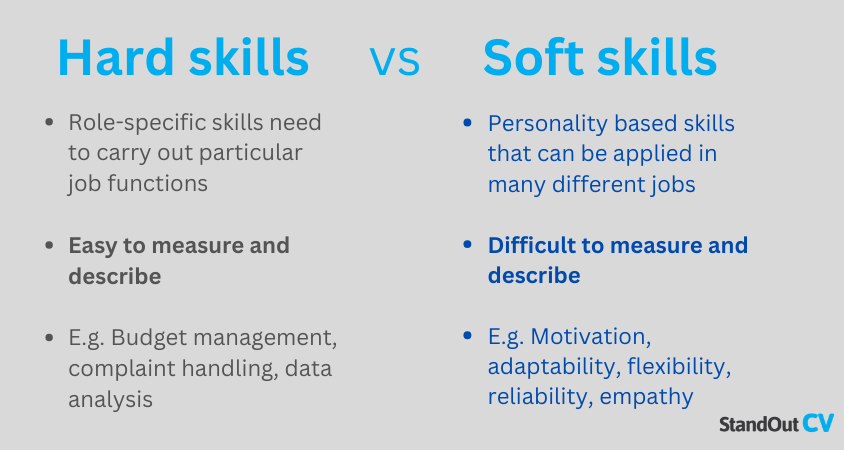
To ensure that recruiters open your CV, you simply need to explain how your skills and experience match the job requirements from the advert.
Scan the job advert to discover what the most important candidate abilities are, and show how your previous experience has prepared you to cover these.
In particular, look out for any requirements that are essential to the job .
Focus on what you have to offer at this stage and not what you want.
At this stage, your covering letter is simply a means of getting the recruiter to open your CV, so it’s too early to talk about salary demands etc. Save that for your initial conversation with the recruiter.
Include a professional signature

End your cover letter with a friendly salutation such as “Regards” and a smart signature which includes your name and most direct contact method (usually mobile phone for most people)
A professional email signature will show recruiters that you understand business-email etiquette and ensure they have a means of contacting you – even if they can’t open your CV for any reason.
Writing a CV cover letter
Hopefully this guide has given you everything you need to create a winning cover letter that will ensure you CV gets opened every time you send it.
Just remember to keep it brief, be friendly, tailor it towards your target role, and give recruiters some good reasons to be interested in you.
Good luck with the job hunt!

COMMENTS
The headline on the image says, "Cover letter format" A woman sits at a table writing on a piece of paper. There's a simple cover letter represented by lines. On one side of the cover letter, there are labels for the sections of the cover letter. The labels are: 1. Date and contact information 2. Salutation/greeting 3. First, introduce yourself 4.
Build your CV now How not to address a cover letter. When you're addressing your cover letter, some things simply aren't worth including. These old-fashioned or overly formal ways of starting a cover letter can make a negative first impression. So, avoid the below phrases in your cover letter greeting:
Using honorific titles when addressing a cover letter. Titles such as Mr. and Ms. are commonly used when addressing a cover letter. However, you should only use these if you know the cover letter's recipient's gender. If you have never met the recruiter or hiring manager, you should never assume their gender by using the Mr. or Ms. titles.
Of course you won't do that. But if you don't know how to address a cover letter without a name, you'll look just as bad. How to Address Cover Letters Without a Name—Examples. Who to address cover letters to if unknown: Good Examples. Dear PM Hiring Manager, Dear Software Engineer Hiring Team, To the Customer Service Search Committee,
For a cover letter, you should always default to addressing it to the hiring manager for the position you're applying to. Unless you know for sure that the culture of the company is more casual, use the hiring manager's first and last name. You can include a title, such as "Mr." or "Ms." (never Mrs. or Miss).
After addressing the recipient, you can add your full cover letter in the body, or you can include it as an attachment along with your resume. If you're including it as an attachment, write a few brief lines that thank the hiring manager for their time and explain that you've attached your cover letter and resume. Tips for addressing a cover letter
A cover letter address is important primarily because it is often the first thing the recipient sees upon opening the letter. If you address your cover letter professionally and appropriately, you're more likely to make a positive impression on the hiring manager or recruiter reviewing your letter. ... Assistant Manager Position - Resume ...
How to address a cover letter Properly addressing your cover letter is a straightforward process. If you follow these simple steps, you should be able to address your cover letter correctly: 1. Examine the job description to find out the name of the recruitment manager The first thing you should do when addressing your cover letter is to refer ...
Knowing how to address a cover letter is a vital job search skill that can give you a competitive edge. ... A dedicated member of the Resume Genius team with a passion for the career space, Corissa is always looking for ways to create useful resources for job seekers, from writing job-specific resume samples to crafting in-depth articles on how ...
In this article, we review how to address a cover letter without a name, including tips to help you find the employer's name and write a cover letter if a name is unavailable. Related: How To Write a Cover Letter: Top 3 Tips, Format & Examples [Video + Transcript]
Here's how to address your cover letter effectively. If you don't personalize the greeting or salutation in your cover letter for each job you apply to, you can kiss your chance of landing the interview goodbye. ... We'll get you a detailed analysis of your resume within 48 hours. Now, we just need to know where to send it! Email Address ...
When it comes to addressing a cover letter, advice columns frequently spotlight these two pitfalls: Mistake 1: Failing to address your cover letter to a specific person; Mistake 2: Addressing a cover letter to the wrong person; Most job postings don't specify who will be reading your cover letter. This puts job seekers in a tricky situation.
The way you address your cover letter can help you make a positive first impression on a hiring manager. Since it's the very first part of the letter that the hiring manager will read, it's helpful to know how to address your cover letter. In this article, we show you how to address a cover letter with a template and example.
1. List your contact details in the header. Your cover letter's header should include your name and contact information so the hiring manager can easily reach out to you if they're interested in interviewing you. Make sure the following information is prominently displayed at the top of your cover letter: Email address
Resume Checker Get your resume checked and scored with one click.; CV Maker Create a CV in 5 minutes. Get the job you want. Cover Letter Builder Write a cover letter that convinces employers you're the best.
Related: Cover Letter vs Resume Key takeaways: When addressing a cover letter, personalise it by using the hiring manager's name if known, including a specific academic or professional title if appropriate, opting for a generic but thoughtful greeting if the recipient's name isn't available.
How To Address a Cover Letter Without a Name: Sample Phrases Starting with Job Title. When you cannot find the recipient's name, use their job title to address the cover letter. This shows that you can connect and direct your message to the relevant person. Here are some examples: Dear Hiring Manager, - This is a common and universally ...
RESUMES/COVER LETTERS RESUMES/COVER LETTERS RESUMES A resume is a brief summary of your qualifications, education, and experiences relevant to your job search objective . ... Most importantly, remember to address the cover letter to a person. If you do not have a name, call the department or human resources to find out to whom your letter ...
In a competitive job market it is crucial to make the best first impression you can. Small things like the cover letter salutation can make a big difference.Nailing the cover letter opening conveys professionalism and adds that personal touch.. It is always best to try and find out the name of the hirer on the company website, by calling the company receptionist, or by looking on LinkedIn.
That's addressing a cover letter to unknown.. Need more how to address cover letters samples? Want the proper address format on a cover letter for CVs? That's next. 1. How to Address a Cover Letter Without a Name. To address a cover letter without a name, you can use some variation of 'Dear Marketing Team Hiring Manager' or 'Dear Hiring Manager'.
A cover letter for your CV, or covering note is an introductory message that accompanies your CV when applying for a job. The purpose of the cover letter is simple… Persuade the reader to open your CV. Learn how to write a cover letter properly, and you will hugely increase your chances of getting responses and landing job interviews.